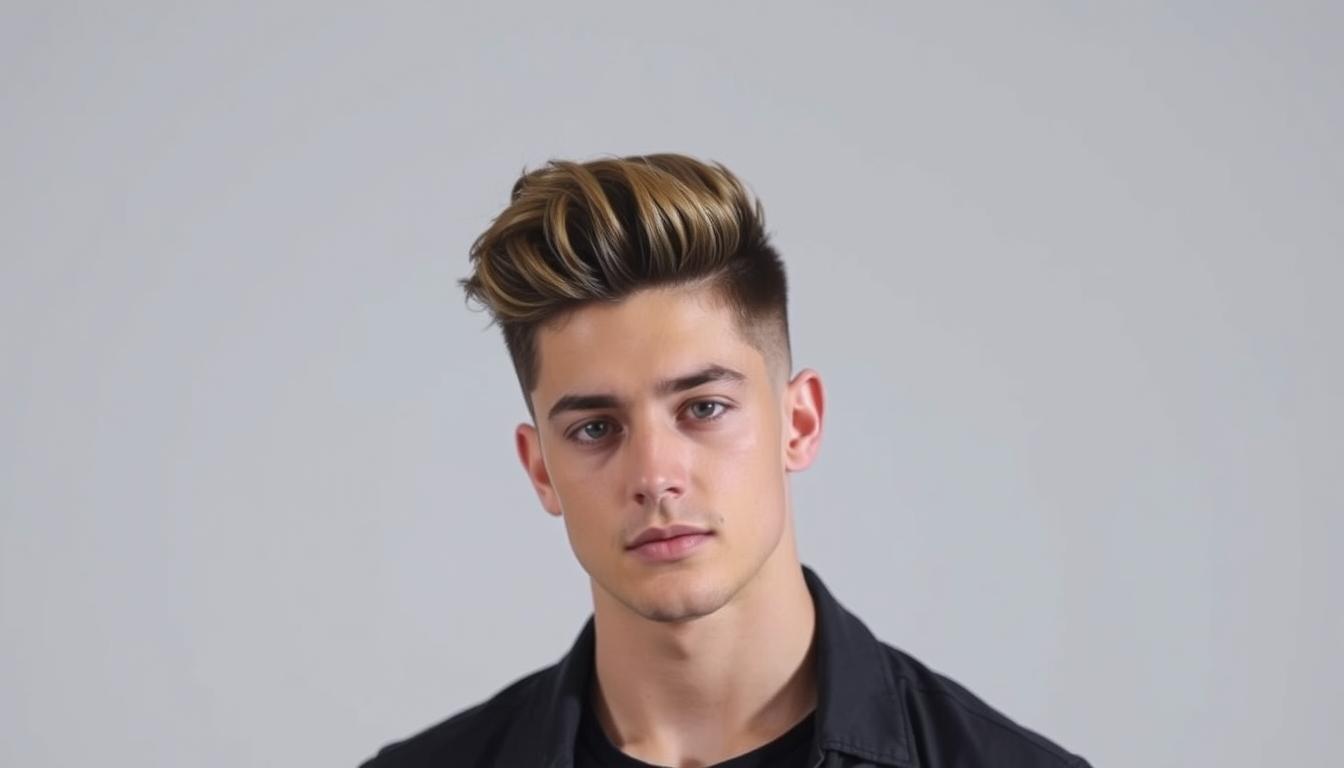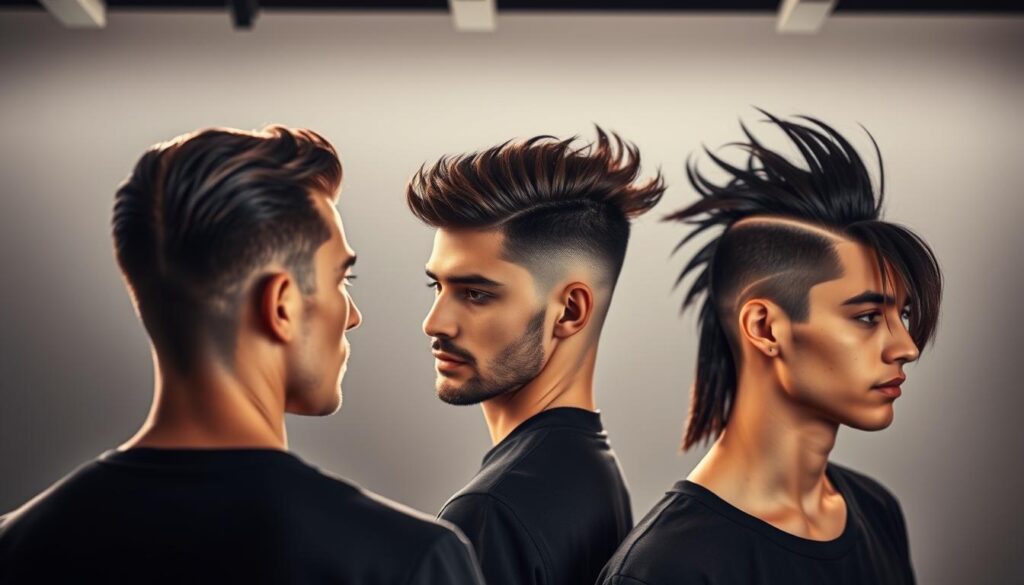
What if the most rebellious hairstyle in history could now fit seamlessly into modern life? Once dismissed as a relic of the 80s, this iconic cut has evolved into a symbol of balanced self-expression—blending vintage edge with today’s polished grooming standards.
Originally popularized by rockstars and wrestlers, the “business in the front, party in the back” philosophy dominated counterculture for decades. Today’s version keeps the bold contrast but refines it with precision techniques. The sides transition smoothly from shorter lengths to longer layers, creating a versatile shape that works in boardrooms and bars alike.
This revival isn’t just nostalgia—it’s about adaptability. Whether your hair is curly, straight, thick, or fine, updated barbering methods tailor the look to your natural texture. Celebrities and influencers have reignited its appeal, proving that individuality and sophistication aren’t mutually exclusive.
Key Takeaways
- Blends retro rebellion with modern barbering precision
- Originated in 1970s-80s counterculture, now embraced by younger generations
- Graduated sides create versatility for professional and casual settings
- Works with all hair types through customized styling techniques
- Balances bold self-expression with refined grooming standards
Understanding the Mullet Taper Fade

This bold hairstyle proves personal expression and professional polish can coexist. Its magic lies in strategic length variations that create visual interest without overwhelming your features.
Defining the Iconic Look
The design follows a simple rule: keep it shorter up front and let the party start at the crown. Skilled barbers use clipper-over-comb techniques to blend lengths from your temples to the nape. This creates a smooth transition that softens the dramatic contrast between sections.
Three elements define the silhouette:
| Taper Placement | Contrast Level | Best For |
|---|---|---|
| Low | Subtle | Office environments |
| Mid | Balanced | Weekend versatility |
| High | Dramatic | Creative professions |
Evolution from Retro Roots to Modern Style
While 80s versions prioritized length extremes, today’s iterations focus on wearability. Textured layers replace blunt lines, allowing natural movement. Your barber might suggest point-cutting ends for a lived-in feel that grows out gracefully.
Contemporary versions work with all hair types. Curly textures get defined with layering, while straight strands benefit from razor detailing. The neckline now follows your natural growth pattern instead of harsh shaving, making maintenance easier.
Top Variations of the Mullet Taper Fade Look

The evolution of this iconic style offers endless possibilities for personal reinvention. From boardroom-friendly updates to daring reinterpretations, today’s versions adapt to diverse lifestyles and hair types. Let’s break down the most sought-after iterations reshaping barbershop trends.
Modern, Mohawk, and Short Mullets
A sleek modern version trims the sides closely while keeping length at the crown and neckline. This approach works well for corporate environments but keeps enough edge for weekend adventures. Textured layers add movement without sacrificing polish.
For those craving drama, a raised center strip pairs with tapered edges to create bold vertical emphasis. This hybrid look turns heads while maintaining wearability. Keep the back section neatly blended to avoid overwhelming your facial features.
{{the}} styles slash maintenance time without losing character. Your barber leaves just enough length at the nape to hint at the classic silhouette. It’s ideal for coarse or wavy textures that naturally hold shape.
Comparing Classic and Contemporary Elements
Earlier versions prioritized stark contrasts between sections. Today’s techniques use gradual blending to soften the transition from shorter to longer areas. This creates a more organic flow that complements your natural growth patterns.
| Feature | Classic Approach | Modern Update |
|---|---|---|
| Side Length | Abruptly cropped | Gradually faded |
| Texture | Uniform layers | Customized cutting |
| Versatility | Limited settings | Day-to-night ready |
Current styling products enhance your hair’s natural behavior rather than forcing it into rigid shapes. Sea salt sprays or lightweight clays build definition for straight strands, while curl creams tame voluminous textures.
How to Achieve Your mullet taper fade
Mastering this bold style requires precision and clear communication. Whether visiting a barber or attempting it yourself, strategic sectioning and tool selection make all the difference.
Step-by-Step Barber Techniques
Start by isolating the crown and back head with clips. Use clippers with a #3 guard on the sides, stopping 1 inch above the ears. Gradually switch to smaller guards as you move downward, creating layered transitions.
| Guard Size | Area Covered | Purpose |
|---|---|---|
| #3 | Upper sides | Base layer creation |
| #2 | Mid-section | Transition blending |
| #1 | Neckline | Sharp definition |
Thinning shears soften harsh lines between sections. Always cut vertically when blending the rest hair into faded areas for natural texture.
DIY Tips for a Seamless Fade
Bring multiple reference photos showing front, side, and back views. Specify desired length proportions using coins as visual guides: “Keep the top as long as a quarter stacked sideways.”
Maintain your look with trims every 3 weeks. Use texturizing paste on dry strands to enhance the shape without stiffness. For DIY touch-ups, invest in adjustable clippers with 0.5mm precision settings.
| Professional Service | Home Maintenance |
|---|---|
| Skin fade detailing | Edge cleanup |
| Custom layering | Product styling |
Essential Styling and Maintenance Tips for Your Look
Keeping your style sharp requires smart product choices and consistent care. The right tools transform your natural texture into a polished statement that lasts all day.
Recommended Haircare Products and Tools
Start with a volumizing shampoo and conditioner. These build body at the roots while keeping strands healthy. For thick hair, apply sea salt spray to damp sections before blow-drying. It creates grip and movement without crunchiness.
Three essentials for daily upkeep:
- Diffuser attachments: Boost volume in curly or wavy top back sections
- Matte clay: Shapes longer layers with flexible hold
- Texturizing powder: Absorbs oil at the crown for lift
Use a round brush when drying the top area to direct growth patterns. For the back hair, scrunch with your palms to enhance natural waves. Reapply styling cream sparingly throughout the day to maintain shape.
Trim sides every 3-4 weeks to keep faded areas crisp. Deep condition weekly to protect longer sections from heat damage. Your look stays fresh when products work with your hair’s natural behavior.
Expert Advice and Trend Insights in the United States
The unexpected style revival began in living rooms nationwide. When barbershops closed during 2020 lockdowns, men discovered new freedom in growing out their hair. This DIY era birthed creative interpretations of the modern mullet, blending practicality with rebellious flair.
Barber Recommendations and Industry Trends
Today’s versions focus on wearability. Expert stylists suggest pairing longer crown sections with subtle skin fades near the ears. “Keep the back head area flowing naturally into the neck,” advises Los Angeles barber Marco Rivera. “It creates movement without looking unkempt.”
Fashion-forward men customize their look through texture. Try tousled waves at the crown or piece-y layers at the sides back. Your barber can adjust bulk based on your face shape – fuller styles balance angular features, while sleeker cuts complement rounder faces.
Maintenance remains key. Schedule trims every 4 weeks to keep faded areas crisp. Use matte pomade on dry strands for that lived-in, effortless finish that defines today’s approach to this iconic style.
